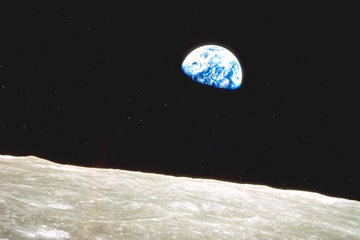To add an image to a page, use the IMG (image) tag with the mandatory SRC (source) attribute and a "value" (which is the image file's address). The IMG tag has no closing tag. Example:
<IMG SRC="http://dvaughan.bol.ucla.edu/a_html/C_images/images/earthMoon.jpg">
You need to supply the URL of the image. URL stands for Uniform Resource Locator. It means the Web address of the file. There are two types of URLs: absolute and relative. The above example is an absolute URL because it will work in any html file you put it in (as long as the image file remains where it is, of course).
The image below uses a local path, which is also called a relative address. Check the code for the IMG tag and SRC attribute for the following image. It is clearly marked in the code with a comment tag. This type of URL address will work only if the RELATIVE relationship of the HTML file to the image file is accurately indicated. Following is a further explanation.

Absolute URLs are what we're all used to seeing in the address bar of a browser. It usually starts with: http://www. For example, here is an image tag with a source attribute that uses an absolute URL for displaying an image:
<IMG SRC="http://dvaughan.bol.ucla.edu/a_html/C_images/images/earthMoon.jpg">
I have made a link using the above absolute URL source attribute to the image file at a remote server . Look at the code for it (it is also clearly marked with a comment tag). Regardless of what html file you put an absolute URL into and regardless of where that html file gets located, it can find the and display the image file as long as the image file stays put where it is.
(Site file structure diagram) Relative URLs don't do the same thing. Instead, they tell the browser what file path to take to find the image relative to the position of the html file that the link is in. For example, a relative URL would look like this:
<IMG SRC="images/earthMoon.jpg">
What the above relative address tells the browser to do to find the image file is something like this:
Look for a folder named "images" in the same folder you're in. Look inside that folder. You should see a file in it called "earthMoon.jpg". Open that file and display it in the browser.
Click here to see the same image you looked at before, except this time it is a relative link to a so-called local image file. Look at the source code for the link. Do you notice any difference? Top
The answer to this depends on the situation. If you have a file with an image, and you will be keeping that file in the same folder structure as the html file when you upload it, then relative is the way to go. If you don't know where your html file will end up, use absolute. Keep in mind that an absolute URL makes the server work harder to find the file, slowing things down a bit.
© 2008 Dan Vaughan and its licensors. All rights reserved.